Our ears may possibly be our most mistreated body part. We pierce them, subject them to deafening noise, shove cotton swabs inside them, and burn them with ear candling. Despite providing us with one of our most important senses, we seldom give our ears, or our hearing, much appreciation or consideration.
That is, right until there are problems. After that, we grasp just how important healthy hearing really is—and how we should have practiced proper ear care earlier. The secret is to comprehend this before the harm is done.
If you want to avoid problems and safeguard your hearing, avoid these 4 hazardous practices.
1. Ear Candling
Ear candling is a method of eliminating earwax, and additionally, as one researcher put it, “the triumph of ignorance over science.”
Here’s how ear candling is done. One end of a thin tube made of cotton and beeswax is inserted into the ear. The other end is set on fire, which purportedly creates a vacuum of negative pressure that sucks earwax up into the tube.
Except that it doesn’t, for two reasons.
First, the ear candle doesn’t generate negative pressure. As expressed by Lisa M.L. Dryer, MD, earwax is sticky, so even if negative pressure was created, the pressure required to suck up earwax would rupture the eardrum.
Second, while the wax and ash resemble earwax, no earwax is in fact found within the ear candle following the procedure. Clinical psychologist Philip Kaushall investigated this by burning some ear candles the standard way and burning other candles without inserting them into the ear. The residue was exactly the same for both groups.
Ear candling is also harmful and is strongly opposed by both the FDA and the American Academy of Otolaryngology (physicians specializing in the ear, nose, and throat), if you require any additional reasons not to do it.
2. Using cotton swabs to clean your ears
We’ve covered this in other posts, but inserting any foreign object into your ear only presses the earwax against the eardrum, creating an impaction and potentially a ruptured eardrum and hearing loss.
Your earwax contains helpful antibacterial and lubricating characteristics, and is naturally removed by the normal movements of the jaw (from talking and chewing). All that’s required from you is standard showering, or, if you do have issues with excess earwax, a professional cleaning from your hearing consultant.
But don’t take our word for it: just look at the back of the package of any pack of cotton swabs. You’ll come across a warning from the manufacturers themselves advising you to not enter the ear canal with their product.
3. Listening to extremely loud music
Our ears are just not equipped to handle the loud sounds we’ve discovered how to produce. In fact, any sound louder than 85 decibels has the potential to initiate permanent hearing loss.
How loud is 85 decibels?
An everyday conversation registers at about 60, while a rock performance registers at over 100. But here’s the thing about the decibel scale: it’s logarithmic, not linear. That means the leap from 60 to 100 does not make the rock concert twice as loud, it makes it about 16 times as loud!
In the same way, many earbuds can create a comparable output of 100 decibels or greater—all from within the ear canal. It’s no real surprise then that this can produce irreparable injury.
If you prefer to preserve your hearing, ensure that you wear earplugs to concerts (and on-the-job if needed) and keep your portable music player volume at about 60 percent or less of its maximum volume (with a 60 minute listening time limit). It may not be cool to wear earplugs to your next concert, but untimely hearing loss is not much cooler.
4. Ignoring the signs and symptoms of hearing loss
Last, we have the unsettling fact that people tend to wait almost ten years from the start of symptoms before seeking help for their hearing loss.
That means two things: 1) people needlessly experience the consequences of hearing loss for 10 years, and 2) they render their hearing loss a great deal harder to treat.
It’s true that hearing aids are not perfect, but it’s also true that with today’s technology, hearing aids are extremely effective. The amount of hearing you get back will be based on on the degree of your hearing loss, and seeing as hearing loss tends to get more serious over the years, it’s best to get tested and treated as soon as you notice any symptoms.

